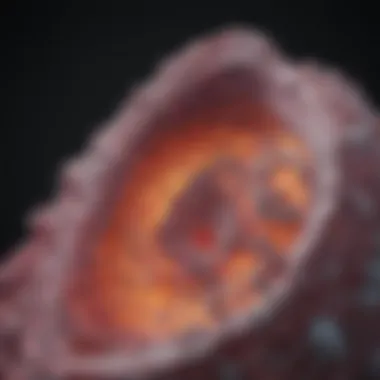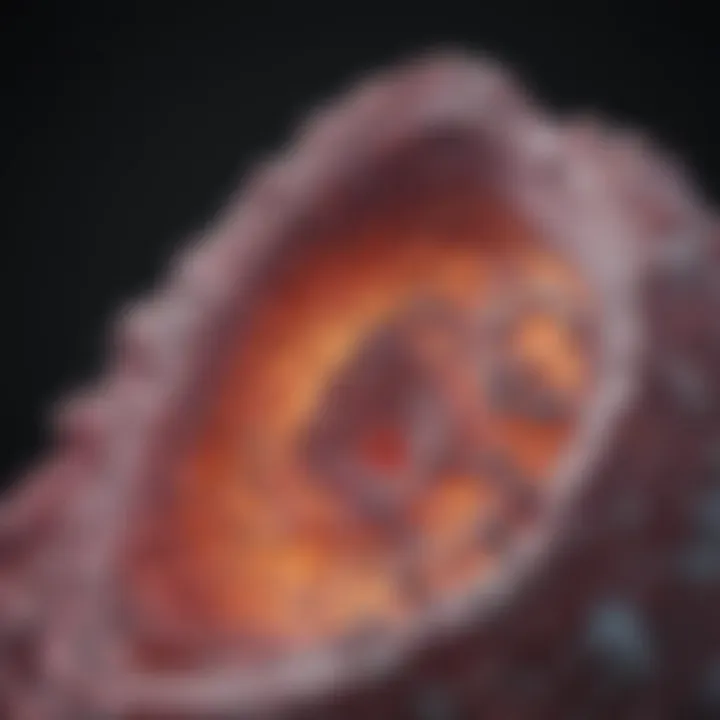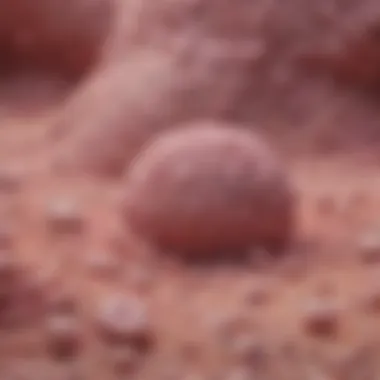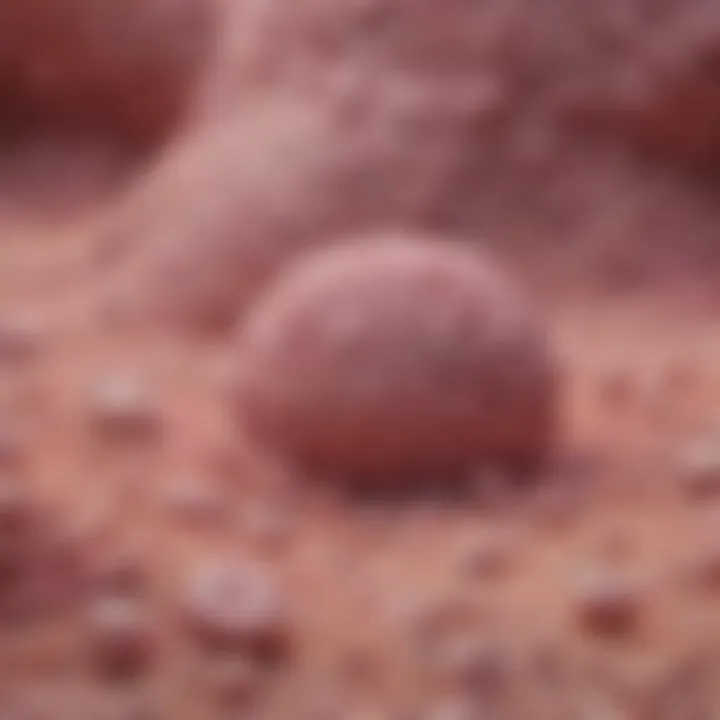Understanding Spiculated Masses in Breast Cancer


Intro
The study of spiculated masses in breast imaging is a crucial aspect of oncology and has far-reaching implications for diagnosis and treatment of breast cancer. Identifying these masses accurately can significantly influence patient management and outcomes. Understanding the nature of spiculated masses helps in distinguishing between benign conditions and malignant tumors, thus guiding clinical decisions. To enhance that understanding, it is important to explore various methodologies involved in the research, implications for patient care, and future directions in this vital area of study.
Methodology
Overview of research methods used
Research on spiculated masses primarily employs a combination of retrospective and prospective studies. Retrospective analyses involve reviewing existing patient data, which helps identify patterns in imaging results. Prospective studies rely on ongoing patient evaluations to gather fresh insights on spiculated masess. These methodologies are instrumental in developing greater clarity around diagnostic approaches.
Data collection techniques
Data on spiculated masses are typically collected through several techniques. Medical imaging techniques such as mammography, ultrasound, and MRI are crucial. These imaging modalities allow for detailed visualization of breast tissue. Medical professionals assess the characteristics such as size, shape, and density of the detected masses. Furthermore, follow-up biopsies provide histopathological confirmation. Integrating imaging results with clinical data can lead to more accurate diagnosis and better patient outcomes.
The detection of spiculated mass can often foretell the presence of malignancy, making accurate diagnosis essential for effective treatment.
Future Directions
Upcoming trends in research
The landscape of research around spiculated masses is evolving. There is a growing emphasis on leveraging artificial intelligence to enhance imaging analysis. Machine learning algorithms can assist radiologists in identifying subtle patterns that might suggest malignancy. Additionally, there is increasing interest in personalized medicine approaches that tailor interventions based on individual patient profiles.
Areas requiring further investigation
Despite advancements, certain areas need deeper study. Understanding the biological mechanisms responsible for spiculation in breast masses is critical. Furthermore, exploration into non-invasive diagnostic techniques could provide significant benefits to patients. Future research could also address the psychological implications of being diagnosed with a spiculated mass, underscoring the need for holistic patient care.
researchers and medical professionals can expand the horizons of this critical area, creating an environment for better diagnostic practices and care.
Prologue to Spiculated Masses
The evaluation of spiculated masses plays a critical role in breast cancer diagnosis. These masses often represent a serious finding in imaging studies, indicating the potential for malignancy. Understanding their characteristics and implications is vital not only for accurate diagnosis, but also for informing treatment decisions. The presence of a spiculated mass can lead to further investigation, often prompting biopsies and additional imaging studies. Clinicians must be well aware of the morphological features and the context of these findings in order to ensure appropriate patient management.
Definition of Spiculated Mass
A spiculated mass is defined as a breast lesion that exhibits irregular, pointed extensions, or "spicules," when viewed through imaging techniques like mammography or ultrasound. These spicules suggest a possible malignancy, as they can indicate that the tumor is infiltrating surrounding tissues. Typically, these masses are distinguished from round or oval masses that may be benign. The appearance of spiculated masses emerges from the interaction of the tumor with the surrounding breast tissue, creating a more chaotic structure, which is often reflective of aggressive biological behavior.
Prevalence in Breast Cancer
Spiculated masses account for a noteworthy percentage of breast cancer diagnoses. Studies indicate that approximately 60-70% of malignant lesions observed in mammography present with this spiculated characteristic. It is essential to note that while spiculated masses are commonly associated with breast cancer, not all spiculated lesions are malignant. Some benign conditions, such as radial scars, can also exhibit spiculated features. Therefore, accurate evaluation of these findings in the context of other clinical data is crucial. Continuous research is necessary to enhance understanding of the prevalence and characteristics of spiculated masses, ultimately aiming to improve diagnostic accuracy and patient outcomes.
Characteristics of Spiculated Masses
Understanding the characteristics of spiculated masses is essential for accurate diagnosis in breast cancer. Spiculated masses often signal underlying malignancy and can lead to promptly needed interventions. The ability to identify and analyze their characteristics can profoundly affect patient outcomes. Here, we will examine the morphological features that define spiculated masses and the critical process of differentiating between benign and malignant forms.
Morphological Features
Spiculated masses typically display unique morphological attributes that set them apart from other breast lesions. They generally have irregular outlines with radiating projections, creating a star-like appearance. This feature is pivotal for radiologists during imaging assessments. The borders are often indistinct, and since they vary in size, they can easily be misclassified if not carefully evaluated.
Certain parameters are significant when examining morphological features:
- Margins: Spiculated masses often have sharp or jagged edges rather than smooth borders.
- Size and Shape: They can vary in size, but most are generally larger than non-spiculated lesions. The irregular shape often raises suspicion.
- Density: On mammograms, spiculated masses may appear denser than surrounding tissue, contributing to their detectability.
Recognizing these features enhances the diagnostic rate, crucial in radiological practices. A misinterpretation can lead to delayed treatment and poor prognosis.
Differentiating Benign vs. Malignant


The process of distinguishing between benign and malignant spiculated masses is crucial in oncological evaluation. While not all spiculated masses are malignant, specific imaging characteristics can guide diagnosis. Radiologists often employ a combination of imaging modalities and clinical information to make this distinction.
Some characteristics that suggest malignancy include:
- Growth Patterns: Malignant spiculated masses may exhibit faster growth rates compared to benign variants.
- Associated Findings: The presence of lymphadenopathy or architectural distortion in surrounding tissue could indicate cancer.
- Microcalcifications: These are often observed in malignancies and can enhance the suspicion for cancer when associated with spiculated masses.
It's also essential for clinicians to consider additional factors such as patient history and physical examination findings when making distinctions. Referral for biopsy may be warranted when malignant properties are suspected, leading to decisive diagnoses and tailored treatment plans.
"The recognition of spiculated masses is a cornerstone in early breast cancer detection, significantly influencing therapeutic outcomes."
Using thorough evaluation techniques and understanding morphological features enhances diagnostic precision. As research progresses, refining the capabilities of imaging techniques further promises to improve differentiation between benign and malignant conditions, reinforcing the importance of advanced training for healthcare professionals.
Diagnostic Imaging Techniques
Diagnostic imaging techniques are crucial for identifying spiculated masses in breast cancer diagnoses. These methods help in distinguishing between benign and malignant tissues. Given the complex nature of breast masses, accurate imaging is essential for developing an effective treatment plan. Each technique has its strengths and limitations, which should be considered during evaluations.
Mammography Protocols
Mammography is often the first imaging modality utilized when a spiculated mass is suspected. Standard protocols typically include both screening and diagnostic mammograms. The purpose of mammography is to visualize the internal structures of the breast, providing clarity on the shape and borders of the masses.
Key protocols involve:
- Two-view imaging: Both craniocaudal and mediolateral oblique views should be obtained. This helps to ensure comprehensive coverage of the breast tissues.
- Compression settings: Adequate compression is necessary to enhance image quality. However, care must be taken to avoid discomfort.
These protocols enhance the visibility of spiculated masses, making it easier to assess margins and architectural distortion. Furthermore, digital mammography can improve detection rates, especially in dense breast tissues, utilizing advanced image processing technology.
Ultrasound Evaluation
Ultrasound is employed as a supplementary tool to mammography. It is particularly useful when further characterization of a mass is required. In cases of spiculated masses, ultrasound assists in clarifying whether an abnormality is solid or cystic, further guiding potential biopsies.
The assessment includes:
- Real-time visualization: Providers can observe the mass in real-time, which is advantageous during guided biopsy procedures.
- Doppler imaging: This helps to assess blood flow patterns, which can indicate malignancy based on vascularity associated with tumors.
An ultrasound is often favored for younger women or those with dense breast tissue, where mammograms may have limitations in sensitivity.
MRI Utility in Diagnosis
Magnetic Resonance Imaging (MRI) is a powerful diagnostic tool that provides high-resolution images of breast tissue. Its utility lies in its ability to catch subtle changes in soft tissue that may not be visible in other imaging modalities. MRI is particularly beneficial for assessing suspicious findings and evaluating the extent of known cancers.
Important aspects include:
- Contrast agent administration: The use of contrast agents enhances the visibility of spiculated masses, allowing radiologists to detect lesions earlier.
- Functional imaging: MRI can provide information about tumor characteristics, including size, distribution, and surrounding tissues.
Although MRI is more expensive and not always a first-line imaging choice, its role is invaluable, especially in cases where other methods are inconclusive.
Effective diagnostic imaging can significantly impact treatment choices and outcomes for patients with breast cancer.
Pathological Evaluation
Pathological evaluation plays a crucial role in the diagnosis and management of breast cancer, especially when it involves spiculated masses. This process encompasses various techniques and analyses that allow for the differentiation between benign and malignant lesions. Proper evaluation can significantly influence treatment decisions and patient outcomes, making it an indispensable part of oncological practices.
Biopsy Techniques
Various biopsy techniques are employed to obtain tissue samples from spiculated masses. Each method has its own indications, advantages, and limitations. Common techniques include:
- Needle Biopsy: This includes fine-needle aspiration (FNA) and core needle biopsy (CNB). FNA is often less invasive and provides rapid results but is less definitive than CNB. CNB offers larger samples, allowing for better histological assessment.
- Vacuum-Assisted Biopsy: This method uses a suction device to retrieve multiple samples from the target area. It is particularly useful for lesions that are difficult to access with standard techniques.
- Surgical Biopsy: In cases where image-guided biopsies are inconclusive, a surgical approach may be required to remove the entire mass for analysis. This is more invasive and carries greater risks but provides the most comprehensive results.


"Accurate tissue sampling is essential, as it directly impacts the subsequent steps in patient care, including staging and treatment planning."
Histopathological Analysis
Once the biopsy is performed, histopathological analysis follows. This involves the microscopic examination of tissue samples to identify cancerous cells and assess their characteristics. Important aspects of histopathological analysis include:
- Cell Morphology: The size, shape, and arrangement of cells can indicate malignancy. For instance, pleomorphic cells or abnormal mitotic figures often suggest aggressive behavior.
- Tumor Grading: This process categorizes tumors based on how different the cancer cells appear compared to normal cells. Higher grades usually indicate a more aggressive cancer, impacting treatment decisions.
- Immunohistochemistry: Specific markers are analyzed to provide additional information about the cancer type. This can influence treatment options, particularly in hormone receptor-positive or HER2-positive cases.
In summary, pathological evaluation forms the bedrock of accurate breast cancer diagnosis. The choice of biopsy technique and the thoroughness of histopathological analysis directly impact clinical outcomes. In the context of spiculated masses, these evaluations become even more critical. They not only guide immediate treatment strategies but also inform long-term patient management and monitoring.
Clinical Significance
The identification of spiculated masses in breast imaging carries profound clinical implications that extend beyond mere diagnostics. These masses serve as pivotal indicators in assessing breast cancer, thereby influencing treatment strategies and patient management.
Staging and Prognosis
Accurate staging is essential for the prognosis of breast cancer. Spiculated masses, often associated with malignancy, can indicate that a tumor is infiltrating surrounding tissues. This feature can lead to a higher stage at diagnosis, which typically correlates with a worse prognosis. Imaging studies, such as mammography and ultrasound, are integral in determining the size and extent of the mass. The presence of spiculation is commonly seen in invasive breast cancers, particularly invasive ductal carcinoma, which is the most prevalent type.
Moreover, the degree of spiculation can provide insights into tumor behavior. Studies suggest that more pronounced spiculated patterns may reflect more aggressive disease features, including a higher likelihood of metastases. Understanding the relationship between spiculated masses and staging informs clinicians about potential outcomes and can help stratify patients according to their risk levels.
In summary, these masses not only aid in the initial diagnosis but also serve as critical biomarkers for staging, ultimately guiding prognosis and follow-up strategies.
Therapeutic Implications
The therapeutic ramifications of identifying spiculated masses are substantial. When these masses are found to be malignant, the approach to treatment can differ significantly compared to benign findings. First, accurate assessment of the mass can lead to more targeted interventions. For example, if imaging suggests aggressive cancer characteristics, clinicians may consider more aggressive treatment options, such as chemotherapy or radiation therapy, before or after surgery.
Additionally, spiculated masses can necessitate multi-disciplinary collaboration. Radiologists, oncologists, and surgeons must work together to formulate a comprehensive treatment plan that addresses the nuances of the diagnosis.
Furthermore, ongoing research highlights the importance of understanding the biological behavior linked with spiculated masses. Certain studies have indicated that these masses may respond differently to various therapies based on their histological features. This emerging evidence suggests that individualized treatment plans that factor in the characteristics of spiculated masses could enhance patient outcomes.
Lastly, understanding spiculated masses contributes to ongoing discussions about breast cancer screening and early detection. As these masses can signify more advanced disease, continued emphasis on regular screenings, particularly for high-risk populations, remains a cornerstone of preventive health in breast cancer management.
"The presence of spiculated masses in breast imaging is a crucial element in shaping the diagnosis and treatment path in breast cancer cases."
Psychological Impact on Patients
The psychological impact of spiculated masses in breast cancer is profound and multifaceted. Patients diagnosed with or even suspected of having a spiculated mass often experience significant psychological distress. It is essential to understand how anxiety and the diagnosis intertwined with this condition affect patients to develop effective support systems and intervention strategies. This section will explore the nuances of anxiety in the context of diagnosis and the role of support systems in mitigating the psychological burden.
Anxiety and Diagnosis
The anxiety that arises from the possibility of cancer diagnosis can be overwhelming. Many people facing the diagnosis of a spiculated mass find themselves grappling with fear of the unknown. The uncertainty surrounding the diagnosis leads to various emotional responses, including sadness, anger, and elevated stress levels. Research indicates that anxiety is not merely a transient feeling for some individuals. Instead, it can escalate into chronic stress, affecting physical and mental health.
Several factors contribute to this anxiety:
- Fear of Diagnosis: The mere thought of facing a potentially malignant condition can be paralyzing.
- Concerns about Treatment: Patients may worry about the implications of treatment and its associated side effects.
- Impact on Daily Life: The fear of how a diagnosis may affect work, relationships, and general day-to-day functioning is prevalent.
Healthcare providers must recognize these anxieties and address them. Studies show that providing clear and comprehensive information regarding the diagnosis and likelihood of outcomes can significantly reduce anxiety levels among patients. Moreover, it is essential to create an environment where patients feel safe to voice their concerns openly.
Support Systems
Support systems play a crucial role in helping patients navigate the psychological challenges associated with a spiculated mass diagnosis. The presence of supportive family members, friends, and healthcare providers can alleviate feelings of isolation and despair. Various forms of support can be beneficial:
- Emotional Support: Listening to concerns and providing empathy can help mitigate feelings of anxiety.
- Educational Resources: Providing patients with detailed information about what to expect can foster empowerment, reducing uncertainty.
- Support Groups: Connecting with others who are facing similar challenges can create a sense of community and understanding.
- Professional Counseling: Mental health professionals can offer coping strategies and interventions tailored to the individual patient's needs.
"Support systems are vital in buffering the psychological impact of a breast cancer diagnosis, providing a safety net as individuals navigate their journey."
In summary, understanding the psychological impact on patients with spiculated masses is crucial in providing a patient-centered approach to care. By addressing anxiety and enhancing support systems, healthcare professionals can contribute to improved patient outcomes and overall well-being.


Advancements in Research
Advancements in research regarding spiculated masses in breast cancer diagnosis are critical for enhancing diagnostic precision and improving patient outcomes. As the understanding of breast cancer evolves, so too do the methods employed to detect and characterize these masses. This section delves into emerging technologies and Future Directions in research that promise to provide deeper insights into the nature of spiculated masses, bridging gaps between current knowledge and clinical application.
Emerging Technologies
Recent years have witnessed the introduction of advanced imaging technologies that offer improved accuracy in identifying spiculated masses. For instance, technologies such as digital breast tomosynthesis (DBT) allow for three-dimensional imaging of breast tissue. This increases the likelihood of detecting subtle differences in mass morphology that may signify malignancy.
Other significant advancements include the integration of artificial intelligence (AI) in radiology. Machine learning algorithms are being trained to identify patterns in imaging data. AI can complement radiologists' assessments by flagging potential areas of concern, thus facilitating more accurate diagnoses. Moreover, new ultrasound techniques enhance the visualization of spiculated mass features, providing better differentiation between benign and malignant lesions.
"The incorporation of advanced technologies in breast cancer diagnostics can lead to earlier detection and better prognosis for patients."
Additionally, molecular imaging techniques, which use targeted radiotracers, may allow for more personalized approaches to identify spiculated masses and assess their biological behavior. This is crucial because the attending oncologist can make informed decisions based on the specific type of cancer.
Future Directions
The road ahead for research in spiculated masses and breast cancer diagnosis is promising. Future studies are likely to focus on refining existing technologies and developing new methodologies that enhance understanding of these masses.
One area of growth is the standardization of imaging protocols across different institutions. By creating guidelines that unify how spiculated masses are assessed, discrepancies in diagnosis could be minimized. This can involve collaborative efforts among radiologists, oncologists, and pathologists.
Furthermore, enhancing patient education on the importance of screening and understanding the implications of spiculated masses will play a significant role in the overall strategy. Research that examines patient perceptions and knowledge gaps may inform educational programs tailored to different demographics.
The application of biomarker research to identify genetic and molecular signatures associated with spiculated masses is another significant future direction. A multidisciplinary approach, combining insights from genetics, radiology, and pathology, may facilitate the development of targeted interventions tailored to individual patient needs.
In summary, advancements in research concerning spiculated masses in breast cancer are essential for refining diagnostic accuracy and improving care. As technologies evolve and researchers explore new avenues, the potential to shift the landscape of breast cancer diagnosis becomes increasingly feasible.
Patient Education and Awareness
Educating patients about spiculated masses in breast cancer is critical. Such education empowers individuals to understand what a spiculated mass is, increasing their awareness of potential risks and the importance of timely diagnosis. When patients are informed, they are more likely to engage in discussions with healthcare providers, ask pertinent questions, and participate actively in their care. This also helps in reducing anxiety, as patients can better process information related to their condition.
Informing Patients
There are several core elements to consider when informing patients about spiculated masses. First, patients should have a clear understanding of what these masses are, including their characteristics and how they can affect breast tissue. Providing visual aids, such as diagrams or images from imaging studies, can enhance comprehension.
Furthermore, patients must also be aware of the various diagnostic techniques, like mammography, ultrasound, and MRI. Clarity regarding these procedures can alleviate concerns about the processes involved. Using language that is easily understood—avoiding medical jargon—ensures that the information is accessible to all patients, regardless of their educational background.
Patients also benefit from understanding the significance of follow-ups and the need for additional testing if a spiculated mass is identified. This knowledge fosters a proactive approach to health management.
Promoting Screening Programs
Promoting screening programs is another vital aspect of raising awareness. Regular breast cancer screenings can significantly increase the chances of early detection. Public health campaigns should emphasize the importance of mammograms and clinical examinations, especially for individuals at higher risk.
Local healthcare providers and organizations must collaborate to enable access to screenings. Informing communities about when to begin screenings and the frequency of follow-ups is crucial. This can be done through community health events, informational brochures, and social media campaigns.
"Early detection through regular screenings can drastically improve treatment outcomes for breast cancer."
By promoting screening programs and creating a culture of awareness, healthcare systems can play a pivotal role in reducing breast cancer mortality rates. Ensuring that patients are well-informed leads to increased participation in these essential health measures.
Ending
The conclusion of this article synthesizes vital insights about spiculated masses in breast cancer diagnosis. Understanding the implications of these masses is paramount for medical professionals and patients alike. Accurate identification and differentiation between benign and malignant spiculated masses can significantly influence treatment plans and patient outcomes.
Summary of Key Points
- Definition and Prevalence: Spiculated masses are critical indicators in breast imaging. Their presence is often associated with malignancy, underscoring the need for careful evaluation.
- Morphological Features: The characteristics of spiculated masses vary, with specific shapes and edges indicating potential malignancy. Skilled diagnosis relies on recognizing these features.
- Diagnostic Imaging: Techniques such as mammography, ultrasound, and MRI play an essential role in identifying spiculated masses effectively. Each method offers unique benefits in visualizing tissue structures.
- Pathological Analysis: Accurate biopsy techniques provide essential information for histopathological analysis. These results guide the subsequent management of breast cancer.
- Clinical Significance: Recognizing spiculated masses helps in staging cancer, monitoring prognosis, and determining treatment approaches.
- Patient Impact: The psychological implications of a diagnosis involving spiculated masses can be profound. Understanding these effects is vital for patient support and care.
Call for Continued Research
Continued research is necessary to enhance our understanding of spiculated masses. Investigating the following areas is crucial:
- Advanced Imaging Techniques: Developing improved imaging modalities could improve diagnosis accuracy and early detection rates.
- Biomarkers: Identifying new biomarkers associated with spiculated masses might refine the differentiation between benign and malignant conditions.
- Patient Education: More resources should focus on educating patients regarding the significance of spiculated masses and the related diagnostic processes. Increasing awareness can lead to better patient involvement in their care.
- Psychosocial Impacts: Further studies on the mental health effects of breast cancer diagnoses linked to spiculated masses can help establish support systems for patients facing such challenges.
By prioritizing these research directions, the medical community can advance understanding, diagnosis, and treatment of breast cancer while enhancing overall patient care.







